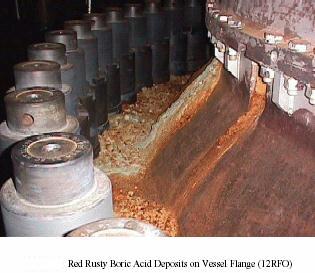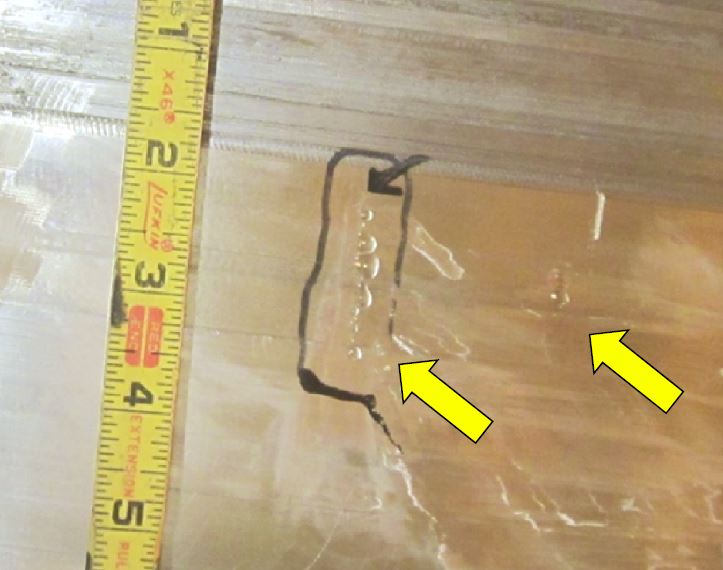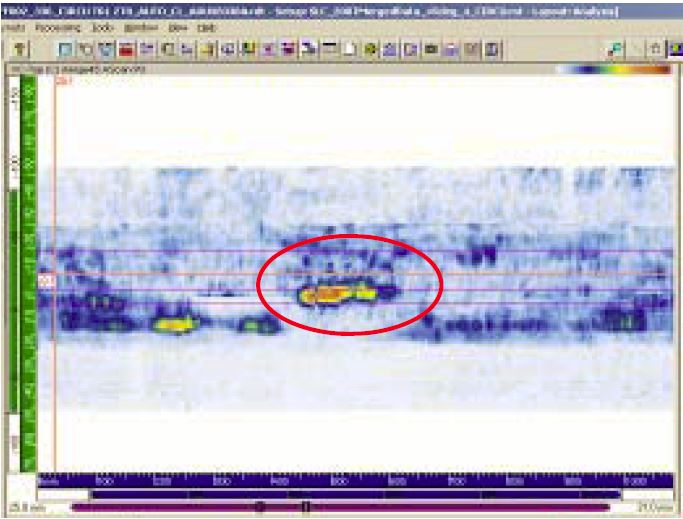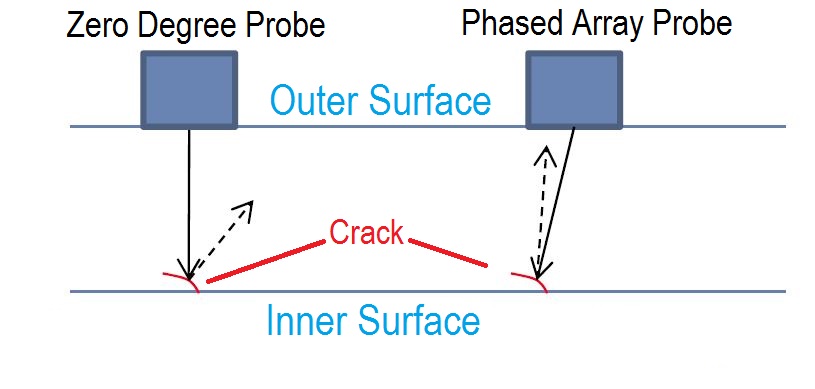Fission Stories #164
The NRC conducted a day-long meeting with industry representatives on June 4, 2013, to discuss plans to improve the reliability of inspections of nuclear plant components per ASME codes.
During this meeting, NRC staffer Stephen Cumblidge provided a presentation about non-destruction examinations (NDE) used to monitor the structural integrity of components. More specifically, Cumblidge covered incidents where NDE became NDE (non-detecting examinations).
(1) The first incident occurred at the Davis-Besse nuclear plant in Ohio. Figure 1 was taken during the refueling outage conducted in the spring of 2000. It clearly showed where rusty streams flowed through holes in the vertical white service platform atop the reactor vessel’s head down the head’s sloped outer surface to pool on the horizontal flange area where the head was bolted to the rest of the reactor vessel. The owner restarted the reactor after assuming the stream was caused by water leaking down onto the head from above. In 2002, workers discovered the source to be a football-sized hole in the head caused by borated cooling water leaking out. The NRC levied a $5.54 million fine for a number of violations, including the botched handling of the inspections in 2000.
(2) The second incident occurred at the North Anna Unit 2 reactor in Virginia. At least five flaws in the steam generator were missed by ultrasonic NDE methods in March 2012 (Fig. 2). A mockup had been used to train workers in the use of the ultrasonic probes and in the evaluation of their results. But differences between the mockup and the actual steam generator introduced inspection and analysis problems that missed the existing flaws. The NRC issued a green finding, the least serious of the four violation gradations, for the misses.
(3) The third incident occurred at the Duane Arnold nuclear plant in Iowa. Workers discovered two large cracks in welds connecting piping to the reactor vessel in 2007. Circled in red in Figure 3 is the indication of cracking in one of the welds. One crack was about six inches long and penetrated 74 percent of the way through the weld’s thickness. The other crack was also about six inches long and extended 55 percent through the weld’s thickness. Both welds had been examined in 1999 and again in 2005 without finding any indications. Once the cracks were discovered in 2007, the 1999 and 2005 results were re-examined. Indications of the cracks were evident both times, but they had been mis-interpreted back then as being something else (such noise and backscatter on the inspection signals.) The NRC issued a green finding, the least serious of the four violation gradations, for the ineffective inspections.
(4) The fourth incident occurred at the Diablo Canyon nuclear plant in California. In 2008, workers applied overlays to several welds in the pressurizer (a large metal tank partially filled with water used to control pressure of and accommodate expansion and contraction of the water flowing through the reactor vessel and its attached piping). Inspections after the overlays were completed found them to be acceptable. Examinations conducted in 2013 identified several flaws—including one nearly 16 inches long—that had been missed by the 2008 examinations. For both examinations, workers ran probes along the outer surfaces of the weld areas. Signals emitted by the probes traveled clear through the welds to the inner surface if no cracks existed. Cracks in the weld bounced the signal back. Workers used a zero degree probe for the examinations in 2008 (Fig. 4). If its signal encountered a crack and bounced directly back, the probe detected it. But if the signal deflected off at an angle, the probe might miss it. For the 2013 inspections, workers used a phased array probe that provided a larger viewing window for detecting cracks. The NRC issued a green finding, the least serious of the four violation gradations, for the ineffective examination method.
Cumblidge’s number one conclusion was that
“No inspection procedure can succeed if the inspectors and/or the licensees rationalize away detected indications.”
Our Takeaway
Conducting an examination that misses pre-existing cracks and flaws is clearly unfortunate because the sole purpose for the examinations is to find problems and restore/retain safety margins.
That past misses are often detected using better inspection techniques strongly suggests that the industry is not satisfied by examination results that paint falsely rosy pictures.
That the NRC sanctioned each ineffective inspection shows that the regulator is helping senior managers who may be reluctant to pay for new and improved inspection methods make the right decisions.
That the worst of the ineffective inspections occurred more than a decade ago suggests that the industry and the NRC are combining to achieve better inspections leading to fewer and smaller surprises.
“Fission Stories” is a weekly feature by Dave Lochbaum. For more information on nuclear power safety, see the nuclear safety section of UCS’s website and our interactive map, the Nuclear Power Information Tracker.




